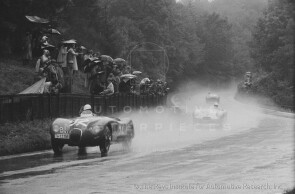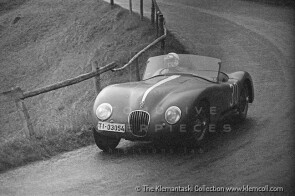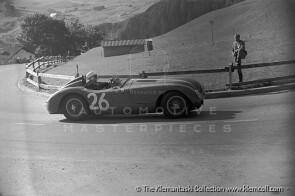
1953 Jaguar C-type
ON/OFF
Why am I an Automotive Masterpiece?
G. Team cars
Squadra Mobo (CH)
In 1950, sensing the image boost provided by a victory at the 24 Heures du Mans, where three specially prepared XK 120 OTSs had performed admirably, Jaguar's management devised an action plan for a new racing car: Sir William Lyons, the company's managing director, and Frank Raymond Wilton "Lofty" England, the manager who a year earlier had founded Jaguar's Engineering Competition Department, its first official racing division, tasked engineer William "Bill" Heynes with designing the racing version of the XK 120, with the precise goal of winning the French endurance race. Heynes decided to design a race car that, leveraging much of the XK 120 OTS's mechanics, would address its weaknesses: the separate chassis body, heavy and not very aerodynamic, and the brakes that were not very durable. Thus, the XK 120-C was designed and built, where C stands for “Competition”, which was soon renamed C-type. It was put into regular production on its own assembly line, alongside the MK VII saloon and the XK 120, and sold in England for £2327. Thanks to regular production and a competitive price, between 1951 and 1953, 53 units were made, of which 10 were allocated to the official Jaguar racing team and the remaining 43 to private drivers, especially US ones. The new car's mechanical components from the XK 120 (engine, gearbox, steering, front suspension) were enhanced by an entirely new tubular frame, lighter and more durable thanks to box-section reinforcements at the most stressed points, designed by Bob Knight. The body, designed by Malcolm Sayer, was made entirely of aluminum, making it lighter and better profiled than the XK 120 OTS's body. The cockpit was spartan: every unnecessary detail was absent for weight reasons. In front of the two leather-covered bucket seats, there was a complete set of instruments: speedometer/odometer, tachometer, oil pressure and temperature gauge, fuel level and water temperature gauge. The occupants were protected only by two small fold-down aeroscreens and a low windshield. The hood and front fenders were united into a single piece, which opened up providing wide access to the mechanics. The trunk space (non-existent) was occupied by a 178-liter fuel tank, with a quick-release cap on top of the fender. The front suspension from the XK 120 utilized deformable quadrilaterals and longitudinal torsion bars; the novel rear suspension used a classic live axle scheme but with a transverse torsion bar, longitudinal reaction rods, and a single triangular reaction arm to contain lateral shaking. This last component was replaced, starting from the end of 1952, by a Panhard rod. The shock absorbers were hydraulic telescopic at both front and rear. The steering was rack and pinion. The braking system was still drum brakes on all wheels but improved thanks to better cooling, guaranteed by the adoption of 6.00/6.50x16" wire wheels, and by the adoption of an automatic slack recovery system. During production, the drum brakes were replaced by disc brakes, making the C-type the first car in the world to successfully use them in racing and on the road. The engine and 4-speed gearbox, originating from the XK 120, were modified for racing: the double overhead camshaft, XK series 6-cylinder inline engine, 3442 cc, fed by two SU H8 carburetors was refined by adopting a new cylinder head, new camshaft profiles, dual side exhausts, and a more accurate general tuning, reaching 200 hp at 5800 rpm and 298 Nm of torque at 3900 rpm instead of the original engine’s 160 hp at 5000 rpm and 262 Nm of torque at 2500 rpm. The car weighed only 1000 kg and was capable of exceeding 230 kmh. The C-type became a protagonist at the 24 Heures du Mans from its debut in 1951. "Lofty" England meticulously prepared the race, bringing three cars to the Circuit de La Sarthe: the first for Stirling Moss - Jack Fairman, the second for Leslie Johnson - Clemente Biondetti, and the third for Peter Walker - Peter Whitehead. Despite excellent trials, the C-types of Moss and Biondetti were forced to retire due to mechanical failures. However, Walker - Whitehead’s car won with a 9-lap lead over the second-place finisher, having led for 16 hours in the rain. After the great victory, Jaguar regularly put the car on sale but officially participated in few other competitions. A notable achievement was a one-two finish at the RAC Tourist Trophy raced at the Dundrod circuit with the C-types of Stirling Moss, first, and Peter Walker, second. Between the 1951 and 1952 sports seasons, Jaguar updated the car: the triangular reaction arm was replaced with a Panhard rod and the two SU H8 carburetors were replaced with three twin-barrel Weber 40 DCO3 carburetors; power increased to 220 hp at 5750 rpm. Development began, in collaboration with Dunlop, on disc brakes. The reliability of the new braking system in races was tested by Stirling Moss and test driver Norman Dewis at the 1952 Mille Miglia. Despite retiring from the race, the two gained enough experience to refine the revolutionary components. For the 1952 24 Heures du Mans, fearing competition from the new Mercedes-Benz W194, the "official" C-types were further modified with a new cooling system and a more aerodynamic body. However, the modifications were not sufficiently tested, and, due to overheating problems, the three cars in the race had to retire. The C-type returned to victory, with a standard body, at the 1952 GP of Reims with Stirling Moss; it was the first official victory for a car equipped with disc brakes. In 1953, all official C-types were equipped with Dunlop disc brakes on all four wheels and, thanks also to these components, the C-type repeated its success in the 24 Heures du Mans achieved in 1951. "Lofty" England presented the same line-ups as in 1952: Peter Walker - Stirling Moss, Peter Whitehead - Ian Stewart, and Tony Rolt - Duncan Hamilton. Hamilton and Rolt won the race, setting a new record with an average speed of over 100 mph: specifically, at 105.85 mph (170.3 km/h). The Jaguar C-type was subsequently replaced by the D-Type, which was a direct evolution, but continued to compete for years in the hands of numerous private drivers. In 2021, 50 years after its debut, Jaguar, through its Classic department, produced 8 "new" C-types, called C-type Continuations, built to the same specifications as the 1953 version.
The C-type with chassis no. XKC 045 was produced and registered in the UK (NDU 289) on March 19, 1953. Despite being one of the later production cars and unlike the "works" cars, it was still fitted with SU carburetors and drum brakes. The car was sold as a “personal export delivery” in Italy through A. Chieregato of the Compagnia Generale Auto (Italian Jaguar distributor, in Milan) to Mario Tadini, a historic Alfa Romeo driver and Mille Miglia veteran, who entered it in the 1953 Mille Miglia with himself, Pietro Cagnana, and Franco Cortese, who, however, did not participate; the car, like most Jaguars that year, retired. The rest of the season was not productive since the car went back to the factory to fit the latest modifications, and Tadini sold XKC 045 to another driver: Ivo Badaracco of Lugano, who used it in hillclimb races. The next two owners, Silvio Moser, and Hans Maag were also drivers and raced with the car, by then aged, until 1965. XKC 045 then crossed the Channel and was acquired by the businessman and renown collector, Sir Anthony Bamford. Subsequent owners included Richard L Hubbard and Nigel Bradshaw from WT Aken and Company in St Anne’s, Lancashire. It appeared in a Motor Sport advertisement from July through September 1970, offered by David Mulvaney at Brian Classic’s in Didsbury, Manchester, and was noted for being restored to concours standards. Bob Roberts, founder of the Midland Motor Museum in Bridgnorth, purchased the car and occasionally had Mike Barker race it. The vehicle was at some point equipped with an early XK 140 SE engine, bearing the serial G 1042-8S; the whereabouts of its original engine remain unknown. In 1983, the Jaguar Daimler Heritage Trust in Coventry became the car's custodian; it was around then that the car received a replica bonnet. The original bonnet was reunited with the car in 2000. The vehicle was featured in the 1993 Jaguar factory procession to Le Mans and has participated in numerous vintage events under the Jaguar Daimler Heritage Trust’s auspices, including appearances at Goodwood, the Ennstal Klassik in Austria with Stirling Moss, and all (13) Mille Miglia from 2003 to 2015. The car is featured in specialized books, such as Sandro Binelli’s Mille Miglia's Chassis - The Ultimate Opus Volume III.





